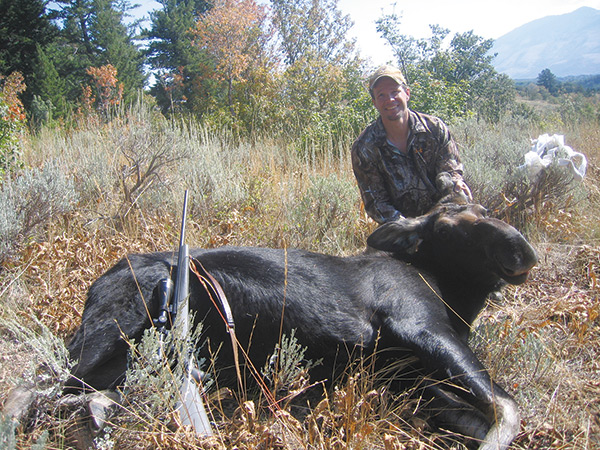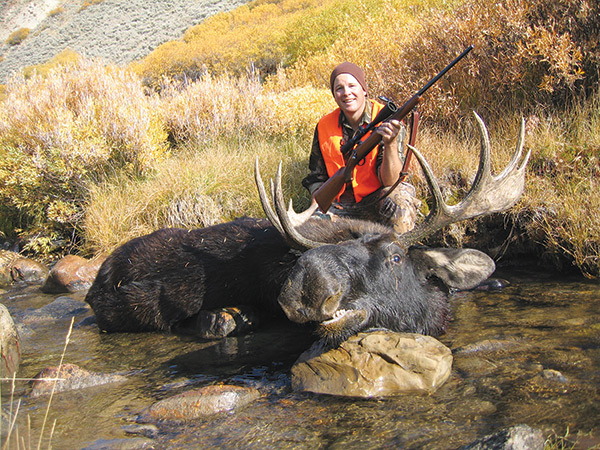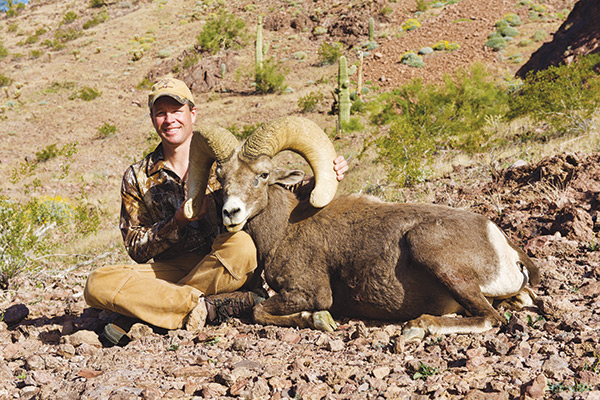 Wilderness Adventure: Playing the Big Game Lottery
Wilderness Adventure: Playing the Big Game Lottery
By Lucas Schmidt

The old adage is true: “You don’t win if you don’t play,” and I’m proof of its validity.
Sneaking along the timberline in the gathering sunlight, my dad and I did our best to stay hidden as a bull elk screamed, bugling at his harem of cows, in a slowly dissipating fog. We crept forward, knowing that our quarry was within a few hundred yards, but still shrouded by a blanket of gray. As the rays of sun began to burn the mist off, the elk herd in the meadow appeared, like light brown ghosts emerging from the gloom.
The cows began to filter back into the forest, but a single bull lingered a bit too long. My 7mm magnum came to bear and I found him in the scope, the 6 x 6 bull now curiously looking in our direction.
I had a hard time holding steady with no nearby rest and the animal 200 yards away. My dad, as he always has in my life, gave me a hand – in this case a shoulder to lean up against to help steady my aim. As soon as he plugged his ears and gave me the go ahead, the rifle barked and my first ever elk hunt came to a glorious end.
If this story sounds familiar it might be because the same scenario has likely played out millions of times in the West. However, this hunt didn’t take place in the mountains of Colorado, Wyoming, Utah or Idaho; the dense Cascade forests of Oregon or Washington; or even the high desert of Arizona or New Mexico. This hunt took place in that mecca of elk hunting: Minnesota. And the only reason it came to pass is because I won the big-game lottery.
I’ve never considered myself a lucky person. Sure, there were times when the sun seemed to shine a little brighter on me, but overall my cosmic ledger had as many check marks in the negative column as in the positive.
However, when it comes to drawing premium big game tags things seem to have worked out well for me. Some might assume this is all due to random luck. But I can definitively tell you there is method to the madness. I’d like to share some insights on how someone with a thirst for adventure and a little bandwidth to do the research can increase their chances in big game drawings.
Set Your Priorities
The first thing I did when I began investigating hunting opportunities was to prioritize both the states and the species I wanted to apply for.
My number one goal was to hunt bighorn sheep, followed by moose and elk. With that in mind, I began researching which states offered tags and which provided the best drawing odds. Money doesn’t grow on any trees in my backyard, so I had to limit the number of states I could apply in. Fully outfitted hunts or private land tags didn’t fit my budget, so DIY was my only option.
Two decades ago, the states with the best odds for sheep were Wyoming and Montana. They didn’t require an applicant to purchase a yearly hunting license, so I started there. When I moved to Arizona, I began to apply in my new home state as well. Low and behold, 17 years later my dream came true. I drew a desert bighorn sheep tag in my adoptive state. I applied for and drew in a unit not known for big rams, which offered better draw odds, but I couldn’t be happier with the ram I ended up taking on that hunt.
The Point System
The next item a perspective “premium” or once-in-a-lifetime hunter needs to understand is how points work versus completely random draws. There are two different kinds of points used in various states with big game drawings: bonus points and preference points.
Bonus points provide the applicant with more chances in the draw the longer they have been applying. Preference points, on the other hand, give the applicant “preference” based on the number of points they have.
For example, in Wyoming a percentage of tags are set aside for only those people with the most preference points. There are pros and cons with each. With bonus points, you have a chance at a tag even with no points, but conversely, your name may never come up. With preference points, applicants know that in time that they will likely draw, depending on the number of tags given out, but it may take a very long time.

Personally, I prefer the eventual certainty of preference points for elk, deer and antelope because I know that I’m eventually going to get to go hunting, and I can plan around it, based on how many points it took to draw a particular tag in previous years. This has served me well in Wyoming, where I’ve been able to plan, knowing that unless something changed in the number of tags or applicants (which unfortunately does happen), I’m likely going hunting within a general timeline.
In 2009, I knew that I had a good chance at drawing a Shiras moose tag in Wyoming with the number of points I had. As a result, I could confidently plan my work schedule around the hunt months in advance.
That fall I spent two glorious weeks on a solo hunt in the rugged but gorgeous Bridger-Teton National Forest chasing bull moose. On October 2, I finally found the mature bull I was after and killed him in a knee-deep stream. While the processing and pack out was the most brutal I’ve ever done on my own, I was overjoyed to have fulfilled a lifelong dream.
Application deadlines
As far as application deadlines are concerned, some states like Alaska start applications as early as December for the next fall. Others might not have an application deadline until June.
I maintain a calendar that has all the application deadlines and species I’ve been applying for and buying points towards, so I don’t have to try to remember every year. Deadlines can and do change, so it’s good practice at the end of the year or the start of the next to check the websites for the current year deadline.
Gathering information
The resources available online now are incredible compared to years past. Almost all game and fish department websites have previous years’ draw odds, success rates, private and public land access information, costs to apply, species distributions and much more. This is the first place to start. Other useful information can come from various online hunting forums, especially when it pertains to the harder-to-draw species like sheep and moose.
People who wouldn’t give their own brother information about their favorite elk or deer spot might offer to meet someone in the field to show then where they’ve seen moose. Once-in-a-lifetime tags tend to bring out the best in people.
Applying for tags
I suggest starting to apply for tags as young as possible. The earlier a person starts accumulating points, the better the chances that a tag will eventually be drawn, especially for states with preference points.
Besides applying in our home state of Arizona, I also purchase relatively inexpensive points in Utah for my 12-year-old son in anticipation that someday we can go on an awesome elk, deer or antelope hunt together.
Another item to pay attention to is population trends. Is there reason to believe that in the future there might be more or fewer tags available in a state? Keep this in mind when determining which tags to apply for each year.
Utah, for example, didn’t give out non-resident cow moose tags for many years, but they still let people buy preference points. I knew, based on population estimates, that someday there would be cow tags offered again, so I dutifully spent $10 per year for eight years to buy a point.
In 2017 the state decided to give out four non-resident cow moose permits. Guess who was at the top of the list for the best public land moose unit in the state?
I had to scramble when I found out in July that I drew the tag for a season starting in September. Fortunately, I connected online with a couple generous locals who offered to point me in a couple directions on my maps. On the third day of my hunt, I glassed up a bull and a cow together from more than two miles away. After negotiating several drainages and ridge lines I found myself sneaking through a small patch of aspen trees where I’d last seen them three hours earlier.
A rouge mountain breeze gave away my position and I heard them crash off, but as they dropped down into the canyon below and began working up the opposite hillside 250 yards away, they stopped for a moment.
This allowed me to catch my breath from the short sprint out of the trees and send a 140 grain Barnes bullet from my .270 WSM into the cow’s shoulder, dropping her on the spot. The cow was my second Shiras moose taken on an unguided, public land hunt, which I’m very blessed to have experienced.
Limited Entry Tags
Playing the big game lottery is not strictly a Western concept. Regardless of where in the U.S. or Canada someone lives, there is likely a limited entry tag available that can provide a unique hunting experience beyond the ubiquitous whitetail deer.
For example, moose are still doing well in the Northeast. A handful of states offer limited tags every fall. In the South, gator and bear tags are given out by draw in a few states. And thanks to numerous relocation efforts, elk now offer viable hunting opportunities in places where 30 years ago this would have been a pipe dream. States like Tennessee, Kentucky, Michigan and Pennsylvania have ever-increasing elk populations and hunts take place every fall for the lucky few.
If someone just wants to hunt, they should avoid applying for known “trophy” areas, or apply for doe or cow tags. Draw odds from previous years are a good guide. Just pay attention to make sure the unit or area for which you’re applying has ample public hunting land or reasonable access to private land. Too many times people have applied for an easy-to-draw tag, received it, then in August started posting on online forums asking for advice on where to hunt. They did little to no research before the draw. Spending the time before the draw will save a lot of trouble.
Also, don’t forget the small-game limited tags. Trappers in more places across the Midwest can now draw tags for otter and bobcats where their populations are relatively small but sustainable with a limited harvest.
Realistic Expectations
My last bit of advice is to have realistic expectations — don’t get down if things change. For example, Wyoming recently changed their non-resident allocation of bighorn sheep permits from 25% of the total to 10%, and there are discussions about changing the points from preference to a squared-bonus point, meaning the number of chances a person gets in the draw is the number of years they’ve applied squared. If this change is implemented, it will mean that my once guaranteed tag under the preference point system has changed to where my effective draw odds will drop to less than 5% in my lifetime.
For someone who spent 23 years and thousands of dollars dutifully buying points, that’s a very tough pill to swallow. But I understand the reasoning behind it. A non-resident just starting out now has no realistic chance at drawing a bighorn sheep tag and the state wants to protect and increase their revenue from point and application sales. Is it fair to the people who have spent more than two decades playing the game? Probably not, but I don’t make the rules.
While the proposed changes in Wyoming hurt, I can’t complain too much. I’ve had the good fortune of drawing once-in-a-lifetime desert sheep and free-range bison tags in Arizona; the bull moose in Wyoming; cow moose in Utah; and the Minnesota bull elk tag on a completely random, 1-in-1,500 draw at the age of 21. I was successful on every one of these hunts unguided, which saved money. The satisfaction of doing it myself made it all that much sweeter.
Soon, I hope to draw a Roosevelt elk tag in Oregon, a bear tag in Minnesota, and perhaps get lucky and finally draw a premium early rifle bull elk tag in Arizona. Oh, and I’m still holding out hope for that Wyoming bighorn sheep tag. After all, somebody has to draw one. It may as well be me. Or, maybe you.
